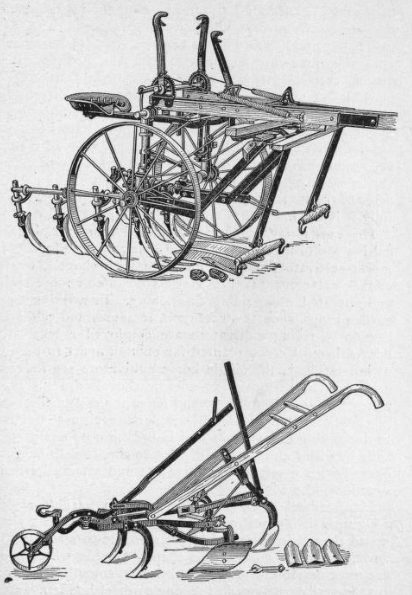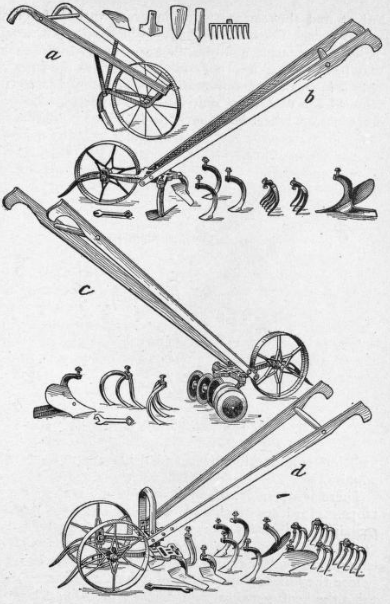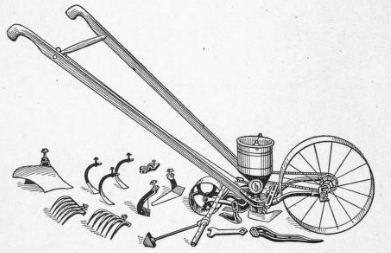71. Cultivation
Description
This section is from the book "Vegetable Gardening", by Ralph L. Watts. Also available from Amazon: Vegetable Gardening.
71. Cultivation
All but one of the purposes of tillage are accomplished by cultivation. The efficiency of cultivation for any particular crop depends upon (1) the character of the tool used, (2) when it is used, (3) how skillfully it is used.
There are two general classes of cultivators, viz., horse-cultivators (Figure 2) and hand cultivators (Figure 3). Horse-cultivators may be provided with shovels, teeth, or rake attachments; they may be for one or more rows and operated when riding or walking. In working field garden crops, such as sweet corn, tomatoes and cabbage, two-horse riding cultivators are employed extensively, but with most crops planted far enough apart to permit of horse-tillage, the single horse cultivators are in general use. Spike-tooth and narrow shovels are the best conservers of soil moisture and leave the soil in the best physical condition, while the broader shovels are effective in destroying large weeds and in breaking up compacted soils. Hillers and shovels of various shapes may be purchased with most horse cultivators and attached when-ever it will be advantageous.

Fig. 2. Different Forms Of Horse Cultivators.
Hand wheel cultivators are made in various styles (Figure 3). They should have rather high wheels with broad tires. Some wheel hoes are made to straddle the rows, others to go between them. Double wheel hoes are most serviceable and economical in smooth, level soil that is easily cultivated; the single wheel hoe is adapted to conditions not so favorable to tillage. Teeth, rakes, knives and shovels are made in great variety for most wheel hoes. The knives as shown in Figure 3 are especially valuable for shallow tillage in sandy soils. They may be shortened in order to cultivate when the rows are only 6 inches apart, although 10 to 14 inches are usually allowed for wheel hoe cultivation. Figure 4 shows a combination wheel hoe and seed drill that is highly valued, but combination hoes and drills are not generally popular.

Fig. 3. DIFFERENT FORMS OF HAND CULTIVATORS.
There is no rule to be followed in cultivating garden crops. Hard crusts should certainly not be allowed to remain unbroken for any great length of time. It is generally best to cultivate as soon as the ground is dry enough after every rain. Frequent tillage destroys weeds before they have made much of a start and it also maintains the best growing conditions in the soil. Crops are never injured by too much cultivation of the proper kind, when the ground is not too wet and the plants are not so large as to make tillage impossible without physical injury.
Level tillage is unquestionably best except for special purposes. Hilling is sometimes justifiable, but the practice is far too general. The main excuse for the practice is that it serves to eradicate weeds when they have gotten very much of a start during wet weather.
Tillage should begin as soon as possible after sowing or transplanting by cultivating about 2 1/2 inches deep at first, decreasing the depth as the crop advances. The importance of reducing the uncultivated row-strip to a minimum width is not fully appreciated by most growers. Workmen can usually get much closer to the rows than they think they can. Cultivators do better work than hand hoes and reduce the cost of tillage.

Fig. 4. Combination Hand Seed Drill And Cultivator.
Continue to:
- prev: 70. Soil Preparation
- Table of Contents
- next: 72. Hoeing
Tags
plants, crops, gardening, cultivated, harvesting, food ,greenhouses, fertiliser, vegitables
